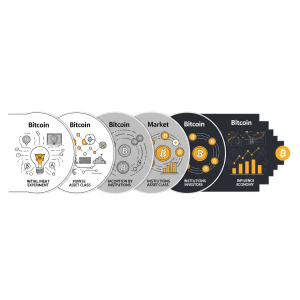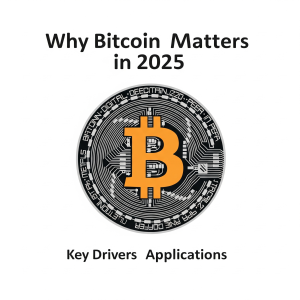
Bitcoin at the Crossroads of Global Relevance
Launched over 15 years ago from a revolutionary whitepaper, Bitcoin was once an idea whispered in the corners of the internet. Today, in 2025, that whisper has become a global dialogue dominating Wall Street boardrooms, political debates, and conversations among investors worldwide. As global finance navigates a post-pandemic landscape of economic uncertainty and rapid digitalization, understanding why Bitcoin matters is more crucial than ever. It has transcended its origin as a speculative asset to establish itself as a fundamental piece in the construction of the future digital economy.
The Evolution of Bitcoin: From Experiment to Macroeconomic Asset
Bitcoin’s journey is a case study in the power of network technology and sound money principles. Its evolution can be seen through three main pillars that have solidified its place in the 2025 financial landscape.

The Explosion of Adoption and Market Capitalization
Bitcoin’s growth has been exponential. From a negligible value, its market capitalization has soared, surpassing the $1 trillion mark and competing directly with traditional assets like silver. A crucial turning point occurred in 2024 with the approval of spot Bitcoin ETFs in the United States, an event that opened the floodgates for institutional capital.
Companies like MicroStrategy have continued to accumulate Bitcoin on their balance sheets, treating it as a primary reserve asset. Furthermore, pension funds and asset managers, once skeptical, now allocate a small but growing percentage of their portfolios to Bitcoin, seeking diversification and asymmetric upside potential. Data from platforms like CoinGecko show a global user base exceeding hundreds of millions, proving that Bitcoin is no longer a niche asset.
The Consolidation of the “Digital Gold” Narrative
The “digital gold” moniker has evolved from a mere marketing slogan to a robust investment thesis. In a world where central banks have aggressively expanded their monetary bases to combat crises, Bitcoin stands out for its most important feature: absolute scarcity. Its supply is mathematically limited to 21 million coins, an immutable and transparent monetary policy. This table illustrates the comparison:
| Attribute | Bitcoin | Gold |
|---|---|---|
| Scarcity | Finite, fixed supply of 21 million (provably scarce). | Relatively scarce, but new supplies are found and mined each year. |
| Portability | Extremely high. Billions of dollars can be moved weightlessly. | Low. Physically heavy and requires secure logistics for transport. |
| Verifiability | High. Easily verifiable on the public blockchain. | Moderate. Requires specialized equipment to verify authenticity. |
| Divisibility | High. Divisible down to 100 million “satoshis”. | Low. Difficult to divide into small units for transactions. |
| Durability | Infinite. Lives on a decentralized network of computers. | High. Does not corrode or decay. |
Technological Maturation and Network Security
Bitcoin’s foundation, its blockchain, has never been hacked. Its security is guaranteed by a computationally vast and decentralized mining network. In 2025, this network is stronger than ever. In addition to the security of the base layer, the Bitcoin ecosystem has matured with crucial innovations:
- Lightning Network: This “Layer 2” solution has grown exponentially, enabling near-instantaneous transactions with negligible fees. The Lightning Network is transforming Bitcoin into a viable medium of exchange for micropayments and daily remittances.
- Protocol Upgrades: Upgrades like Taproot (implemented in 2021) continue to enhance the network’s privacy, efficiency, and smart contract capabilities, paving the way for more complex use cases.
Why Bitcoin Matters in 2025: Key Drivers and Applications
Bitcoin’s relevance today is driven by its ability to solve real-world problems that legacy systems cannot or will not address.

Hedge Against Inflation and Economic Instability
For millions of people in countries with unstable currencies, such as Argentina, Turkey, or Nigeria, Bitcoin is not a speculative investment; it’s a survival tool. It offers an escape route from currency devaluation and government-imposed capital controls. While fiat currencies can be printed at will, Bitcoin’s predictable monetary policy makes it an anchor of stability in a sea of economic uncertainty.
Financial Inclusion and Decentralized Finance (DeFi)
According to the World Bank, over a billion adults worldwide remain unbanked. Bitcoin offers a radical solution. With just a smartphone and internet access, anyone can tap into a global financial system. Through Decentralized Finance (DeFi) platforms, users can save, borrow, and trade without the need for a bank, empowering entrepreneurs in emerging markets and allowing freelancers to receive international payments quickly and cheaply.
Individual Sovereignty and Control Over Assets
The phrase “not your keys, not your coins” encapsulates one of Bitcoin’s most important principles. Unlike money in a bank account, Bitcoin can be held in self-custody. Using hardware wallets from companies like Ledger or Trezor, the user has full, sovereign control over their funds. In an age of increasing digital surveillance and potential banking instability, this ability to “be your own bank” is an increasingly attractive value proposition.
The Maturing Regulatory Landscape
Cryptocurrency regulation has evolved from outright bans to a search for careful integration. In 2025, the landscape is a mosaic, as summarized below:
| Region/Country | Regulatory Stance (as of 2025) | Key Developments |
|---|---|---|
| United States | Integrated but Contested | Approval of spot ETFs solidified its investment status. Ongoing debate between SEC and CFTC. |
| European Union | Regulated Framework | Implementation of the |
Frequently Asked Questions (FAQ)
Q1: What is the main reason Bitcoin is valuable in 2025?
The primary reason is its verifiable digital scarcity. With a fixed maximum supply of 21 million coins, it acts as a store of value and a hedge against the inflation and devaluation of fiat currencies, a function often compared to “digital gold.”
Q2: Is Bitcoin a good hedge against inflation?
Yes, for many investors, this is one of its core value propositions. Because its supply is finite and cannot be altered by any government or central bank, it tends to preserve purchasing power over time when traditional currencies lose value due to monetary supply expansion.
Q3: Is it too late to invest in Bitcoin in 2025?
While Bitcoin’s price has increased significantly, many analysts believe it is still in the early stages of its global adoption curve. Growing institutional integration, regulatory clarity, and the expansion of its use cases suggest potential for continued growth. However, like any investment, it carries risks and should be approached carefully as part of a diversified portfolio.
Q4: What are the biggest risks associated with Bitcoin?
The main risks include price volatility, ongoing regulatory uncertainty in some jurisdictions, cybersecurity threats (like phishing and exchange hacks), and the personal responsibility required for the secure self-custody of your assets.
Q5: How is Bitcoin’s environmental impact being addressed?
The mining industry is progressively moving towards renewable energy sources (hydro, solar, wind). Additionally, innovative practices like using flared natural gas and integrating with power grids for stabilization are helping to mitigate its environmental impact and make the energy narrative more positive.
Q6: Will Bitcoin replace traditional currencies like the Dollar or Euro?
It is unlikely that Bitcoin will completely replace established fiat currencies in the short to medium term. Instead, it is more likely to coexist as a global store of value, an alternative investment asset, and a settlement network for international and digital transactions, complementing the existing financial system.
NEW: Q7: What are spot Bitcoin ETFs and why did they matter so much?
A spot Bitcoin ETF (Exchange-Traded Fund) is a regulated financial product that allows investors to gain exposure to Bitcoin’s price without having to buy and store the cryptocurrency themselves. They trade on traditional stock exchanges. Their approval in the U.S. in 2024 was a landmark event because it provided a simple, secure, and regulated on-ramp for vast amounts of institutional and retail capital, legitimizing Bitcoin as a mainstream investment asset.
NEW: Q8: What is “self-custody” and why is it important?
Self-custody means you hold and control the private keys to your Bitcoin yourself, typically using a hardware wallet, rather than leaving them with a third party like a cryptocurrency exchange. It’s important because it gives you full sovereignty over your assets. The saying is “not your keys, not your coins,” meaning if you don’t control the keys, you are trusting a third party not to be hacked, go bankrupt, or restrict your access to your funds.
NEW: Q9: Is Bitcoin anonymous?
No, Bitcoin is not anonymous; it’s pseudonymous. All transactions are recorded on the public blockchain and are visible to everyone. While transactions are linked to wallet addresses (the “pseudonym”) rather than personal names, analysis can often link these addresses back to real-world identities. For this reason, it is more accurate to think of the Bitcoin blockchain as transparent.

